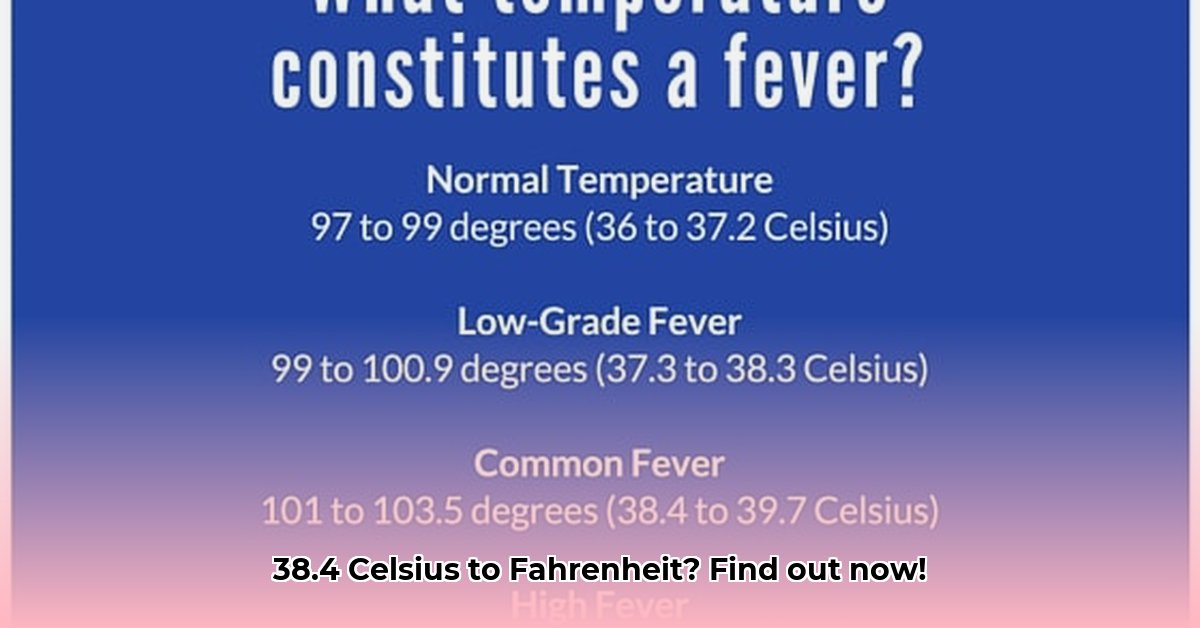
Ever wondered how to convert Celsius to Fahrenheit? It's more than a simple calculation; it's a journey through the history of temperature measurement! This guide will show you precisely how to convert 38.4 degrees Celsius to Fahrenheit (it's 101.12°F!), step-by-step. But we'll also explore the fascinating story behind these temperature scales—their creation, why we still use both, and even the tiny discrepancies you might encounter. Whether you're a scientist needing precise measurements or simply curious, this guide provides the tools and knowledge for accurate conversions and a deeper understanding of the science involved.
From Celsius to Fahrenheit: More Than Just a Calculation
First, the straightforward part: the conversion formula. We use F = (9/5)C + 32. Substitute 38.4 for C (Celsius), and you get 101.12°F (Fahrenheit). But where did this formula originate? Why not a simpler one? Let's explore.
A Little History Lesson: Two Ways to Measure Heat
Celsius and Fahrenheit are like two different rulers measuring the same thing: temperature. Celsius, predominantly used by scientists, is based on water's freezing (0°C) and boiling (100°C) points. Fahrenheit, more common in the US, has a less intuitive starting point. Understanding their histories clarifies why the conversion formula isn't arbitrary; it reflects the different ways these scales were originally defined.
Did you know that early thermometers didn't have standardized scales? This makes comparing historical temperatures challenging. The development of accurate, standardized scales was a gradual process, marked by innovations and improvements over centuries.
Beyond the Numbers: Why Perfect Precision is Tricky
While the formula is simple, achieving a perfectly accurate Fahrenheit equivalent of 38.4°C isn't always guaranteed. The Celsius scale relies on water's freezing and boiling points, which are slightly affected by air pressure—higher altitudes mean slightly different boiling points. Thermometer accuracy also plays a role; a basic thermometer might differ slightly from a high-precision lab thermometer. These differences might seem negligible in everyday life, but in scientific research or industrial settings, they become significant.
Who Cares About Accurate Temperature Conversions? A Lot of People!
Accurate temperature conversions aren't solely for scientists. Software developers creating weather apps need precise formulas to ensure accurate temperature displays. Data scientists working with historical climate data must handle Fahrenheit and Celsius measurements correctly to avoid skewed results. Even tiny conversion errors can significantly impact the analysis of large datasets, like centuries of climate data.
Putting it All Together: Practical Uses and Future Research
Converting 38.4°C to Fahrenheit is more than just applying a formula; it's a glimpse into the world of measurement, history, and the pursuit of precision. It involves recognizing the limitations of measurement tools and the complexities of the physical world. Ongoing research continues to improve our understanding of temperature scales and refine conversion methods.
Potential Pitfalls: A Quick Summary
This table summarizes potential sources of error in Celsius-to-Fahrenheit conversions:
| Source of Error | Impact on Result | Mitigation Strategy |
|---|---|---|
| Thermometer Inaccuracy | Small to significant error | Use a calibrated, high-quality thermometer |
| Air Pressure Differences | Minor changes in boiling/freezing points | Account for altitude and atmospheric pressure |
| Historical Variations in Definitions | Minor discrepancies | Use modern, standardized conversion methods |
Remember, while the formula is simple, understanding the context and potential errors is crucial for accuracy.
How to Accurately Convert Celsius to Fahrenheit Considering Historical Variations
Key Takeaways:
- The formula F = 9/5C + 32 remains accurate, but historical variations in scale definitions and precision impact results.
- Understanding the evolution of temperature scales is crucial for interpreting historical data.
- Inconsistent historical data collection requires careful consideration during conversion.
- Achieving precise conversion requires awareness of error sources.
- Modern digital tools offer high precision, but historical data analysis necessitates acknowledging inherent uncertainties.
Let's revisit the precise conversion of 38.4°C to Fahrenheit.
Step-by-Step Conversion
- Substitute: F = (9/5 * 38.4) + 32
- Multiply: 9/5 * 38.4 = 69.12
- Add: 69.12 + 32 = 101.12
- Result: 38.4°C = 101.12°F
Historical Context: A Tale of Two Scales
The formula's simplicity masks a rich history. Celsius and Fahrenheit scales evolved gradually. Early thermometers lacked standardized scales, making the comparison of historical temperature readings complex. The accuracy of a measurement depends on the instrument and conditions. Atmospheric pressure influences boiling and freezing points; older thermometers had coarser gradations, introducing inherent errors. These historical inconsistencies are critical when analyzing past temperature records.
Modern Applications and Challenges
Modern digital thermometers minimize measurement error. However, the challenge of historical data persists. Software and online converters must account for the limitations of historical data, sometimes providing error margins alongside the conversion. Scientists employ advanced statistical methods to refine and interpret historical data, considering the limitations of earlier measurement techniques. Careful consideration of these factors is crucial for accurate analysis.